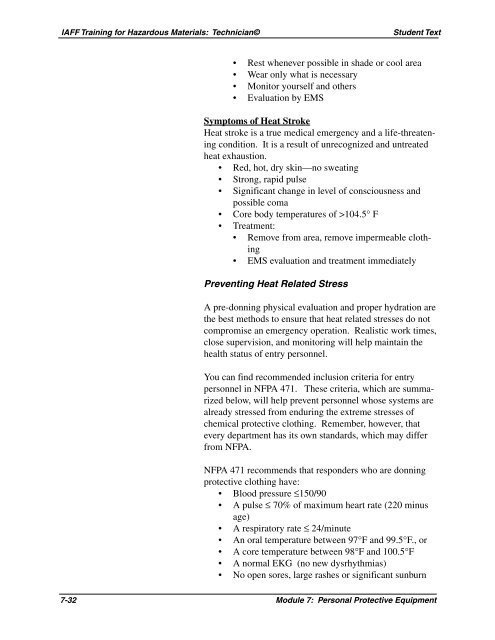Module 7 - IAFF
Module 7 - IAFF
Module 7 - IAFF
Create successful ePaper yourself
Turn your PDF publications into a flip-book with our unique Google optimized e-Paper software.
<strong>IAFF</strong> Training for Hazardous Materials: Technician©<br />
Student Text<br />
• Rest whenever possible in shade or cool area<br />
• Wear only what is necessary<br />
• Monitor yourself and others<br />
• Evaluation by EMS<br />
Symptoms of Heat Stroke<br />
Heat stroke is a true medical emergency and a life-threatening<br />
condition. It is a result of unrecognized and untreated<br />
heat exhaustion.<br />
• Red, hot, dry skin—no sweating<br />
• Strong, rapid pulse<br />
• Significant change in level of consciousness and<br />
possible coma<br />
• Core body temperatures of >104.5° F<br />
• Treatment:<br />
• Remove from area, remove impermeable clothing<br />
• EMS evaluation and treatment immediately<br />
Preventing Heat Related Stress<br />
A pre-donning physical evaluation and proper hydration are<br />
the best methods to ensure that heat related stresses do not<br />
compromise an emergency operation. Realistic work times,<br />
close supervision, and monitoring will help maintain the<br />
health status of entry personnel.<br />
You can find recommended inclusion criteria for entry<br />
personnel in NFPA 471. These criteria, which are summarized<br />
below, will help prevent personnel whose systems are<br />
already stressed from enduring the extreme stresses of<br />
chemical protective clothing. Remember, however, that<br />
every department has its own standards, which may differ<br />
from NFPA.<br />
NFPA 471 recommends that responders who are donning<br />
protective clothing have:<br />
• Blood pressure ≤150/90<br />
• A pulse ≤ 70% of maximum heart rate (220 minus<br />
age)<br />
• A respiratory rate ≤ 24/minute<br />
• An oral temperature between 97°F and 99.5°F., or<br />
• A core temperature between 98°F and 100.5°F<br />
• A normal EKG (no new dysrhythmias)<br />
• No open sores, large rashes or significant sunburn<br />
7-32 <strong>Module</strong> 7: Personal Protective Equipment
















